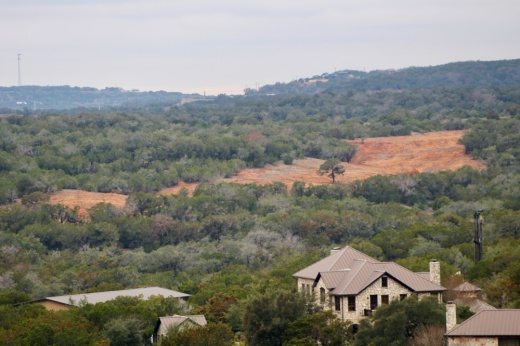In recent years, multiple developers have eyed untouched areas of the Hill Country to build resort-style neighborhoods near the lake.
Two large developments promising to bring nearly 4,000 homes—Travis Club and Thomas Ranch—received approval from Travis County to begin construction in 2023, despite ongoing pushback from residents.
Two-minute impact
The Travis Club and Thomas Ranch developments are currently the largest planned for the Spicewood area.
Longtime residents voiced concerns to the county prior to approval, fearing that a large influx of residents would create more traffic congestion, strain the dwindling water supply and put the endangered golden-cheeked warbler species at risk of habitat loss.
Despite these concerns, developers said they will preserve resources by using reclaimed water for watering golf courses and planting native species.
“Protecting the local environment and infrastructure is paramount for us with any project,” Travis Club CEO Leisha Ehlert said in a statement.
Joe Rentfro, the managing director for Thomas Ranch, echoed the sentiment, saying, “We are trying to develop a community ... for the enjoyment of future generations by protecting, preserving and conserving the landscape in which people live.”
What they're saying
Spicewood residents from neighboring areas have voiced numerous concerns about the incoming developments.
Pollock said the Siesta Shores neighborhood relies on wells for their water, and at least three residents had their wells dry up in early summer due to the drought.
“All of us out here have experienced troubles with water capacity and having to redrill our wells,” Pollock said.
Kamila Radford, an Angel Bay neighborhood resident, said the increased traffic from the Travis Club development on the curvy, two-lane roads with no shoulders could make evacuation or emergency response difficult.
Quote of note
- "It takes a split second for all of these woods around here to catch on fire," Spicewood resident Kamila Radford said. "Things can get really out of hand really quick."
- "We can't keep wiping out parts of the ecosystem and not expect to have adverse effects to our own well-being," Briarcliff resident Laura Mordecai said.
“We are handcuffed,” Travis County Commissioner Brigid Shea said during the July 18 meeting to approve Travis Club’s Phase 1 plans. “We hear your concerns; we are just legally limited in what we can do.”
Travis County Commissioner Ann Howard said recent legislation, House Bill 3699, prohibits local governments from requiring a traffic impact analysis from a proposed development. Additionally, a 2019 “shot clock” statute, HB 3167, places strict limits on the amount of time the county has to deliver a decision on a new development.
Despite these limitations, Howard said she remains optimistic about the ongoing collaboration between the county and developers to mitigate resident concerns, which include plans to widen roads and address crowded intersections.

Zooming in
The water supply has been a concern around the region since Lake Travis hit a near-decade low in the summer. The addition of thousands of new homes has only increased community concerns.
“The drought is not over,” said Shannon Hamilton, the executive director of the Central Texas Water Coalition—a nonprofit organization advocating for policies to preserve the Central Texas water supply. “We have to recognize what is best for the current residents. ... These projections of population growth are terrifying.”
The Lower Colorado River Authority approved water use permits for both developments and regulates how their wastewater is managed, said Public Information Officer Clara Tuma.
The average daily water usage for a single-family household is 246 gallons, according to the Texas Water Development Board. Travis Club’s 274 single-family homes will use an estimated 67,404 gallons daily, while Thomas Ranch’s 1,618 will use an estimated 398,028 gallons daily.
What else?
The Lake Travis area is one of the few remaining breeding grounds for the endangered golden-cheeked warbler bird species, which nests in the region’s abundant Ashe juniper forests.
A 2022 survey conducted by Blaire Wildlife Consulting around the perimeter of the Travis Club property found 42 of the warblers, which has sparked concerns among residents.
Despite these findings, Travis County can issue permits to allow developers to remove endangered species’ habitat from September to March each year as the birds migrate to Central America. Outside of this timeframe, only the federal government has the authority to stop the removal of habitat.
What’s next?
While the developments will not be completed for years, residents can expect to see changes in the coming year as roads, water systems and amenities are built out.
Loraloma, the first phase of Thomas Ranch, has broken ground on the golf course, and is currently selling their initial real estate, Rentfro said, with the first anticipated move-ins in 2025.
While only Phase 1 of Travis Club has been approved, the full plan is not expected to change significantly as future phases go through approval, said David Armbrust, a lawyer for Travis Club.






